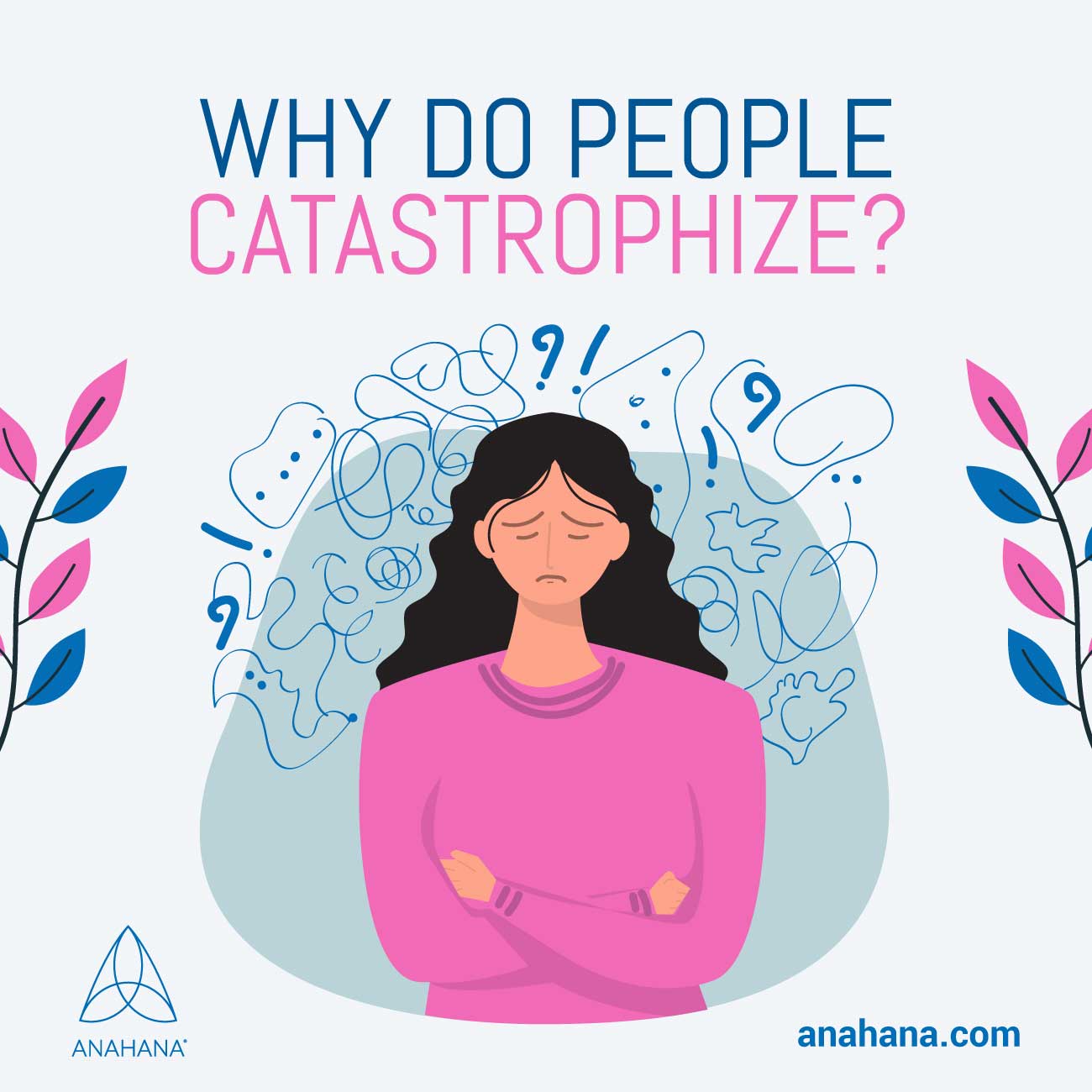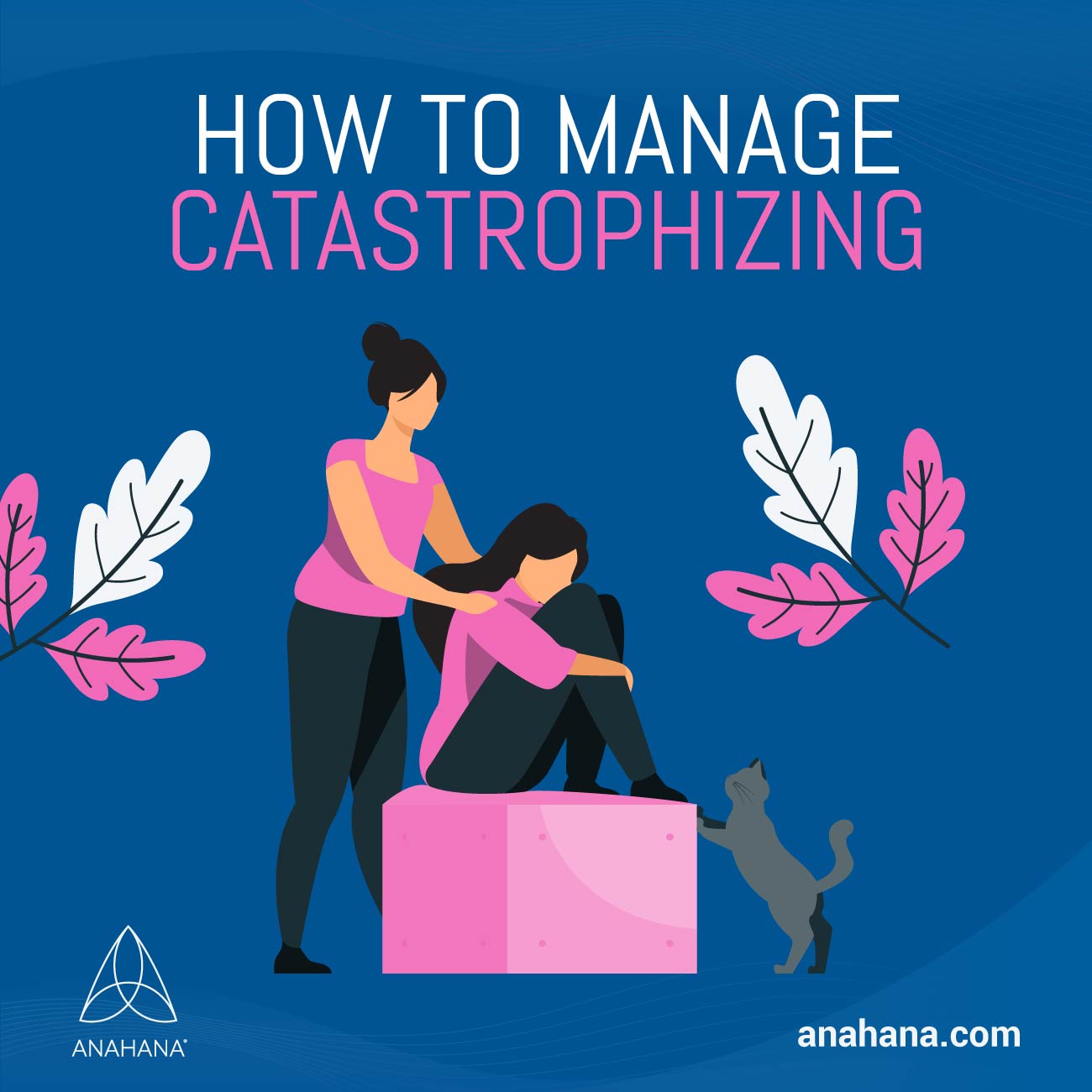
Table of Contents
Learn about the concept of catastrophizing, the underlying causes, signs, and symptoms of catastrophic thinking, and various techniques you can use to identify and manage catastrophizing.
What is Catastrophizing
Catastrophizing is a cognitive distortion or pattern of negative thinking that often leads us down a path of imagining the worst possible outcomes. It is like a mental magnifying glass, where even the smallest concerns can balloon into looming disasters or the worst-case scenario.
We all contemplate the potential consequences of life’s twists and turns, but catastrophizing takes it to another level. We may feel like we are living in a perpetual state of bracing for impact, anticipating doom around every corner.
Consider the nervous energy before a job interview, or the anxious thoughts about our health. These situations can consume us and trigger waves of panic and stress that may their way through our minds and bodies.
While not officially classified as a mental health condition, catastrophizing chips away at our sense of self-worth, while leaving us feeling like we are constantly falling short in a world filled with both imagined and real disasters.
Moreover, engaging in catastrophic thinking can be a risk factor for more serious mental health issues like depression, anxiety, and post-traumatic stress disorder.
Origin of the Term Catastrophizing
The term "catastrophizing" finds its roots in the work of Albert Ellis and Rational Emotive Behavior Therapy (REBT) around 1962. Ellis observed how some individuals, particularly those dealing with anxiety and depression, tended to dwell on the worst possible outcomes of situations.
Within the framework of REBT, catastrophizing arose from irrational beliefs that hindered people from reaching their goals.
Consider thoughts like “This is terrible, everything's falling apart!”—these kinds of ideas trigger negative feelings, making our distress even worse.
In essence, catastrophizing involves predicting the worst-case scenarios, and it can really take a toll on our emotional well-being. But by challenging these negative beliefs, we can start to ease our distress and build up our resilience.
Why Do People Catastrophize?

Catastrophic thinking often emerges from the deep well of fear and anxiety within us. It's rooted in our past experiences, traumas, and the behaviors we've learned along the way. Understanding the emotions driving these thoughts is key to unraveling and managing our tendencies to catastrophize.
There's a myriad of factors that contribute to catastrophic thinking. Sometimes, it's a shield we wield against disappointment—a coping mechanism of sorts. It's like we've absorbed the age-old advice of “looking on the bright side but preparing for the worst” to an extreme degree. Stress, whether from family, friends, or workplace stress, often fans the flames of catastrophizing. It can also stem from worries about health, conflicts, life changes, or loss.
Moreover, chronic or severe catastrophizing might signal deeper mental health struggles. It's like our minds get stuck in a loop of learned helplessness, unable to break free from the grip of negativity.
This can, in part, be attributed to the default mode network: a collection of brain regions that communicate with one another and shape our inner thoughts and narratives. When this communication is disrupted, perhaps due to trauma, anxiety, or depression, our inner dialogue can turn bleak, overwhelming us with catastrophic thoughts.
So, in a way, there is brain connectivity supporting catastrophizing or the “stuckness” of our thinking.
Core Signs of Catastrophizing
While the way catastrophizing manifests can vary from person to person, there are common signs that can serve as guideposts along the way:
-
Magnification: This is when our minds tend to magnify the potential for something negative to occur. It's like a tiny worry grows into a looming shadow, casting doubt over our future. We may catch ourselves wondering, "What if something bad happens?"
-
Rumination: Ever find yourself stuck in an endless loop of thoughts, unable to break free from their grasp? That's rumination at play. We replay scenarios in our minds, dissecting every detail and obsessing over potential outcomes. The thoughts become like a broken record we can't seem to turn off
-
Feelings of Helplessness: When we fall into the trap of catastrophizing, it's easy to slip into a sense of helplessness. We convince ourselves that things will never improve, regardless of our efforts. It's like we're stuck in a cycle of despair, unable to see a way out. Thoughts like "Things will never get any better no matter what I do" may become all too familiar
These signs, while subtle, can serve as gentle reminders to pause, take a breath, and reassess our thought patterns. By recognizing these patterns early on, we empower ourselves to challenge them and cultivate a more balanced perspective. After all, self-awareness is the first step towards transformation.
Conditions Associated with Catastrophizing
“We will also do better when we can recognize the worry thoughts as signs of nervousness and anxiety, the same as an eye twitch or sweaty palms, rather than some important message about the future” ― David A. Carbonell, The Worry Trick: How Your Brain Tricks You into Expecting the Worst and What You Can Do About It.
Catastrophic thinking can lead to feelings of hopelessness that can contribute to existing conditions or co-morbidities, including chronic pain, mood and anxiety disorders, and fatigue.
Catastrophizing and Chronic Pain
For those dealing with chronic pain conditions, catastrophizing can become a constant companion or automatic thought pattern, making the pain feel even worse. Pain catastrophizing happens when we can't stop thinking about how much we hurt.
Avoidance behaviors, driven by the fear of worsening pain, only exacerbate the symptoms. Research indicates that individuals who catastrophize about their pain often experience heightened distress, feelings of hopelessness, and depression, intensifying their suffering.
Depression and Anxiety Disorders
Catastrophizing, a common experience in depression and anxiety disorders, greatly magnifies the challenges individuals encounter in their daily lives. It involves fixating on worst-case scenarios, which can spiral into a relentless cycle of negative thoughts and emotions.
depression, catastrophizing fuels overwhelming worries about the future and a deep sense of hopelessness. Individuals may find themselves constantly anticipating negative outcomes, which dims their ability to find joy and hope in life.
With anxiety disorders, catastrophizing might involve imagining the worst-case scenario in every situation. It can make us feel like we're constantly on edge, waiting for something terrible to happen. This kind of thinking can be exhausting and make it hard to relax or feel safe.
Fatigue
Feeling tired all the time? Catastrophizing might be playing a role there too. Studies suggest that constantly worrying about things can make us feel even more exhausted. It's like our thoughts are weighing us down, making it harder to find energy for the things we enjoy.
Catastrophic Thinking in Teens and Children
Catastrophic thinking isn't exclusive to adults; it can also affect children and teens, albeit in different ways. In little ones, this pattern of thinking often manifests as excessive worry about everyday events or situations. Children may imagine the worst possible outcomes, such as failing a test or being rejected by friends, and become overwhelmed by these thoughts.
For teenagers, catastrophic thinking can escalate during periods of significant change or stress, such as transitioning to high school, facing academic pressures, or navigating social relationships. Adolescents may catastrophize about their academic performance, social status, or future prospects, which can exacerbate feelings of anxiety, insecurity, and even imposter syndrome.
Research suggests that catastrophic thinking in children and teens is associated with heightened levels of anxiety and depression. It can interfere with their ability to cope effectively with challenges and setbacks, impacting their emotional well-being and academic performance.
Encouraging meditation for kids provides them with a structured tool to develop mindfulness, emotional awareness, and inner calm, fostering resilience and well-being from an early age.
Addressing Catastrophizing

Mindfulness and Relaxation Techniques
Mindfulness serves as a powerful tool in mitigating catastrophizing tendencies. It encourages individuals to tune into their emotions and thoughts while anchoring themselves in the present moment. Practices like meditation, journaling, yoga, prayer, and positive self-talk offer avenues for individuals to navigate anxiety and cultivate mindfulness.
Engaging in relaxation techniques, such as regular exercise, balanced nutrition, sufficient sleep, outdoor activities, and pursuing enjoyable hobbies, can also help alleviate stress and anxiety. Nurturing relationships, finding supportive communities, and embracing positive outlets are vital for individuals striving to combat catastrophizing tendencies.
Therapeutic Interventions
Therapy, particularly talk therapy and cognitive behavioral therapy (CBT), has proven efficacy in addressing catastrophizing, especially when associated with mental health conditions. Research underscores the effectiveness of CBT in managing and understanding pain catastrophizing among individuals with fibromyalgia.
CBT delves into cognitive restructuring and reframing, targeting the underlying thought and behavioral patterns fueling catastrophizing. Therapists guide individuals in identifying and challenging repetitive catastrophic thoughts, replacing them with positive and realistic alternatives.
Exposure Response Prevention therapy (ERP) helps individuals break free from catastrophic thinking patterns by gradually facing their fears and learning healthier responses, ultimately reducing the intensity of their anxious reactions.
Mindfulness-based cognitive therapy (MBCT) equips individuals with tools to identify and regulate irrational negative thoughts, fostering resilience in the face of distress.
In Acceptance Commitment Therapy (ACT), individuals learn to accept their thoughts and emotions without judgment, focusing instead on actions that align with their values. This approach helps break the cycle of catastrophic thinking by encouraging mindfulness and acceptance. By recognizing that thoughts are just thoughts and not reality, individuals can choose how to respond in ways that reflect their values, leading to a more meaningful life.
“[Worries, anxieties, fears] WAFs, along with other emotional pain and hurt, are not your enemies. They are your teachers. Think about that for a moment. Without experiencing disappointment, you’d never learn patience. Without the hurt and frustration you receive from others, you’d never learn kindness and compassion. Without exposure to new information, you’d never learn anything new. Without fear, you’d never learn courage and how to be kind to yourself. Even getting sick once in a while has an important purpose—strengthening your immune system and helping you to appreciate good health”― John P. Forsyth, The Mindfulness and Acceptance Workbook for Anxiety: A Guide to Breaking Free from Anxiety, Phobias, and Worry Using Acceptance and Commitment Therapy.
Positive Psychology
In positive psychology, there's a beautiful understanding that we all harbor inherent strengths and virtues that can guide us towards brighter paths, even in the midst of challenges. Take, for instance, the simple act of gratitude journaling, where we pause to reflect on the blessings in our lives, big and small. It's like planting seeds of gratitude that eventually blossom into a sense of abundance, shifting our focus from what could go wrong to what's already right.
Moreover, positive psychology underscores the importance and value of our social connections. By nurturing relationships and reaching out to others, we create webs of support that cushion us in times of need.
Acts of kindness and shared laughter become our beacons of light, guiding us through even the darkest of times. In the embrace of these practices, we find solace, strength, and the unwavering belief that brighter days are always within reach.
Medication
There is no specific medication to prevent catastrophizing. However, if catastrophizing is linked to an underlying condition like depression, doctors, including psychiatrists and mental health nurse practitioners, may prescribe antidepressants, including benzodiazepines, beta-blockers, and selective serotonin reuptake inhibitors (SSRIs).
Mental health nursing often involves close collaboration with these healthcare providers to monitor medication effectiveness and support individuals in managing their mental health concerns.
Take Away
Catastrophizing is a common experience where situations seem far worse in our minds than they are in reality. While it's something many of us encounter, when catastrophic thoughts begin to dominate and disrupt daily life, they can take a toll on both physical and mental well-being. This pattern of thinking is closely tied to various mental health conditions, amplifying stress and diminishing overall quality of life.
Thankfully, there are pathways to ease the burden of catastrophizing. By grounding ourselves in the present moment and exploring therapeutic approaches like mindfulness, relaxation techniques, or medication, we can start to alleviate the weight of constant worry and anxiety.
Seeking guidance from mental health professionals and therapists can also provide invaluable coping strategies tailored to individual needs, helping to unravel the grip of catastrophic thinking and foster greater resilience in facing life's challenges.
Frequently Asked Questions
Why do I always imagine the worst-case scenario?
Catastrophizing often emerges from a deep-seated fear of uncertainty and a desire to prepare for the worst. Our minds tend to magnify potential threats, even if they're unlikely to happen. It's like our brains are trying to protect us by preparing for the worst possible outcome.
How can I tell if I am catastrophizing?
Pay attention to your thoughts and emotions. If you find yourself constantly fixating on negative possibilities, exaggerating the severity of situations, or feeling overwhelmed by minor setbacks, you might be catastrophizing. Notice patterns in your thinking and how they affect your mood and behavior.
Is catastrophizing a sign of weakness?
Not at all. Catastrophizing is a common cognitive distortion that many people experience, especially during times of stress or uncertainty. It's a natural response to perceived threats, but it's important to recognize when it becomes excessive and starts to interfere with daily life.
How can I break free from catastrophic thinking?
Practice mindfulness and grounding techniques to bring yourself back to the present moment and calm your mind. Challenge negative thoughts by questioning their validity and considering alternative perspectives.
Seek support from friends, family, or a therapist who can help you develop coping strategies and reframe your thinking patterns. Remember, you're not alone, and it's okay to ask for help when you need it.
References
Catastrophizing and Decatastrophizing: A Comprehensive Guide
Catastrophizing: The Worst Thing Ever
Understanding Catastrophizing and How to Stop It
What is catastrophizing? 6 ways to stop catastrophic thinking

By: Anahana
The Anahana team of researchers, writers, topic experts, and computer scientists come together worldwide to create educational and practical wellbeing articles, courses, and technology. Experienced professionals in mental and physical health, meditation, yoga, pilates, and many other fields collaborate to make complex topics easy to understand. Anahana is also home to specialists in crystals, tarot, angel numbers, astrology, life path numbers, zodiac signs, and horoscopes. By combining evidence-based wellness with spiritual and energetic practices, the team offers clear, trustworthy guidance for both mind-body health and modern spirituality.